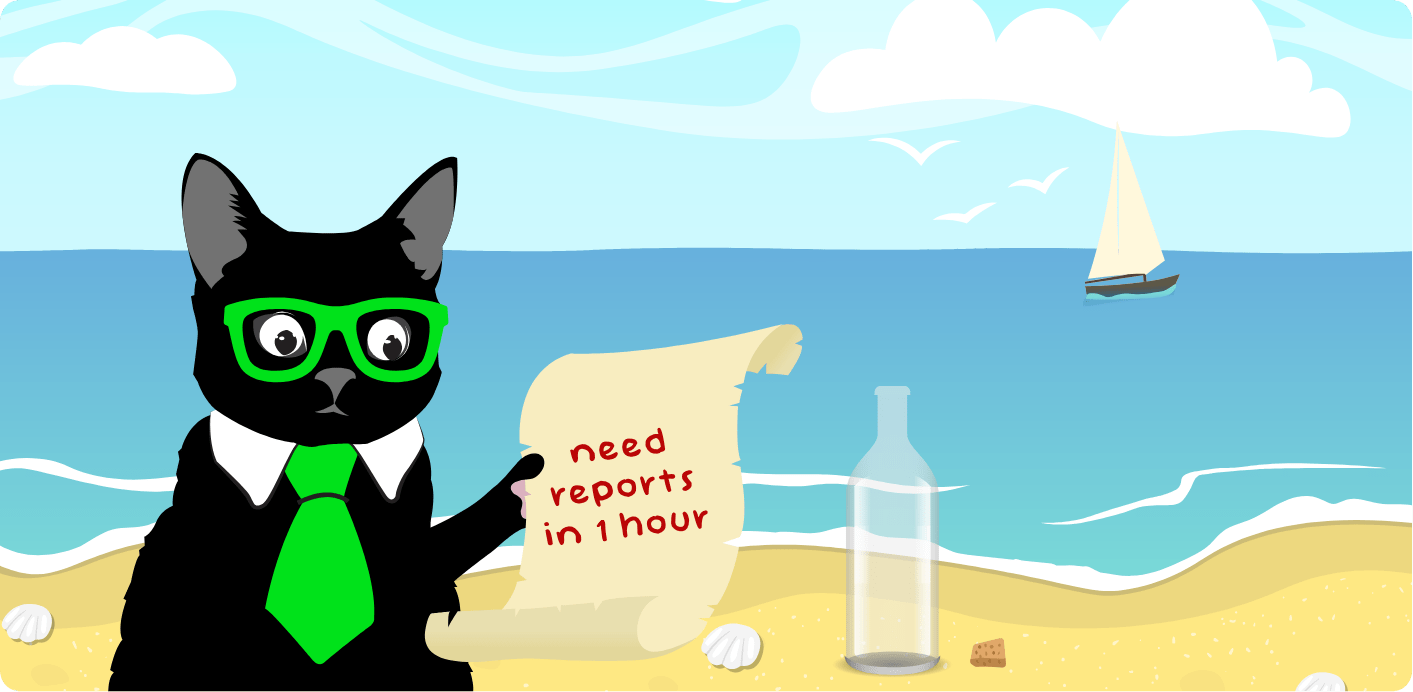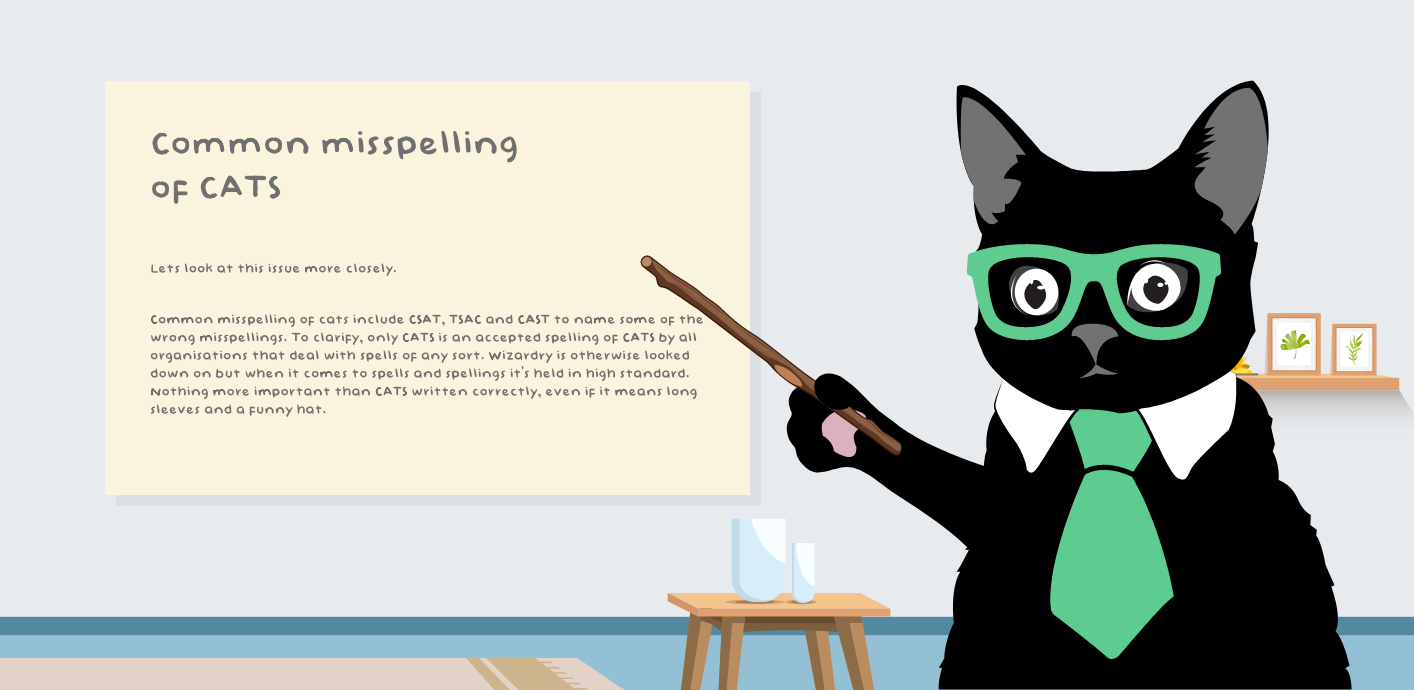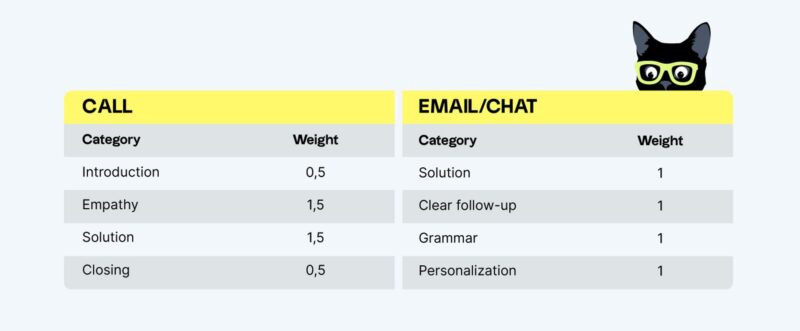Trying to track relevant metrics in your call center?
By now, you’re probably drowning in data. And the fact that you can find over 30 recommended call center metrics to measure just doesn’t help.
What is a typical KPI for a call center?
Let’s focus on 3 areas that matter for most call centers:
- Agent performance — Average Handle Time (AHT), First Response Time (FRT), First Call Resolution (FCR), Service Level, Call Abandonment Rate
- Customer experience — Customer Satisfaction Score (CSAT)
- Support quality — Internal Quality Score (IQS)
Call center metrics: Agent performance
There is no single KPI that you can rely on to fully evaluate the performance of your call center agents. Since your team handles different issues and interacts with various customers, a more comprehensive approach is needed to understand how well your agents are performing.
Try the combination of the following call center KPIs:
Average Handle Time (AHT)
Average Handle Time (AHT) is the average amount of time that a call center agent spends handling a customer interaction.
The handling time refers to all the tasks that your agents have to complete in a single interaction. For example, greeting the customer, collecting information, resolving the problem, and taking care of any post-call tasks, like documentation or follow-ups.
Average Handle Time formula:
Total time spent on resolving conversations / Total number of conversations = AHT
According to the latest Customer Service Quality Benchmark Report, 25% of all surveyed CX professionals track AHT.
No wonder. AHT provides insights into the efficiency and effectiveness of your customer service operations. It’s also closely linked to other ticket-based metrics like replies per conversation, call volume, cost per ticket, and CSAT.
By analyzing the average talk time, call center managers can pinpoint bottlenecks, implement improvements, and schedule agent shifts more effectively.

Average First Response Time (FRT)
Average FRT, meaning First Response Time, is the duration between a customer making a call and an initial response by an agent.
Total First Response Time for all calls received / Total number of interactions = Average FRT
If you use call center software to answer customer calls, you should be able to find these numbers using the reporting features.

There’s one thing to mention, though. Unless your call availability is 24/7, your Average FRT is best measured during business hours. This way, it won’t be affected by inbound calls on nights or weekends.
But, why is measuring FRT in your call center worth the effort?
Let’s face it: The vast majority of customers expect fast and efficient service, and FRT is a key factor in meeting those expectations.
A quick and effective response can help build trust and loyalty with customers. On the contrary, long wait times can lead to frustration, dissatisfaction, and even loss of business.
That being said, FRT is a valuable performance indicator for customer service teams, as it helps to:
- Gain insights into the efficiency of call center operations;
- Identify coaching opportunities;
- Manage workload capacity and accurately forecast staffing needs.
According to the latest Customer Service Quality Benchmark Report, the First Response Time (FRT) benchmark for 2023 is 4h42min.
![]()
First Call Resolution Rate (FCR)
First Call Resolution Rate (FCR) tracks the percentage of calls that are resolved in a single interaction with a support agent, without the need for a follow-up.
The formula for calculating FCR is:
(Number of calls resolved on first contact / Total number of calls received) x 100 = FCR %
According to the latest Customer Service Quality Benchmark Report, the FCR benchmark for 2023 is 70%. A high FCR like that indicates that a company’s support team is able to resolve customer issues quickly and effectively, which can lead to increased customer satisfaction and loyalty.

More than 30% of surveyed customer service professionals measure First Call Resolution Rate (FCR). If you want to assess the efficiency of call center support operations, set realistic goals, and im-purrr-ove your team’s ability to resolve issues in a single interaction — FCR measurement is the way to go.
Service level
Service level is the percentage of phone calls answered within a specific period of time that you set as the target for your call center agents.
Having a Service Level Agreement (SLA) in place is crucial for any call center. It sets a benchmark for managing expectations and improving customer satisfaction, just to name a few.
Ultimately, it’s up to each call center to set its own service level standards. Knowing the above-mentioned metrics like AHT, FCR, and FRT should help you set realistic expectations for your call center.
To calculate your Service level, divide the number of inbound calls answered within your target time by the total number of calls received. This will give you the percentage of callers who received a timely response.
(The number of calls answered within the target time / Total number of calls received) x 100 = Service level %
There’s one thing to mention: In some call centers, service levels may dip during the first or last few hours when staffing is limited. However, when all shifts are covered during peak hours, service levels tend to be better. In such cases, relying solely on the daily average can be misleading. It’s best to take a look at different intervals instead and examine peak-hour traffic closely.

Call Abandonment Rate
Call abandonment rate is a call center KPI that shows the total number of customers who hang up while waiting to speak with an agent.
To track abandoned calls, take the difference between the number of phone calls received and the number of calls handled, and then divide that by the number of incoming calls.
([Number of calls received – Number of calls handled] / Number of calls received) x 100 = Call Abandonment Rate %
What’s interesting about this metric is that the “acceptable wait time” varies from one customer base to another. Again, if you’re using call center tools, you can use the metrics like Average Hold Time or Time in Queue to determine the threshold for how long your customers are willing to wait on hold before their experience turns negative.
According to Thomas Laird, CEO of Expivia:
So, when a client tells us they need to reduce headcount, we delve into their analytics. We might discover their customer base can wait up to a minute and fourteen seconds without a negative impact on sentiment. This knowledge allows us to optimize staffing, maybe moving an agent from service to sales, thereby saving costs without compromising customer satisfaction.
Call center analytics is a powerful tool that allows you to make informed decisions, optimize resources, and improve customer experience. Speaking of…

Call center metrics: Customer experience
Here’s the thing: Focusing too much on agent performance metrics may result in a prioritization of speed over quality.
A fast response time doesn’t necessarily mean that the customer’s issue was resolved appropriately or that the customer was satisfied with their experience. In fact, if the initial response is rushed or incomplete due to a focus on speed, it can actually lead to a worse customer experience down the line.
Sending out feedback surveys and measuring call center metrics like Customer Satisfaction Score (CSAT), Customer Effort Score (CES) or Net Performer Score (NPS) is important to get a full picture of the call center performance.
CSAT
Customer Satisfaction Score (CSAT) measures how well your call center meets customer expectations.
CSAT is measured at the individual level, meaning that users are questioned separately (How satisfied are you with the support received?), and sometimes anonymously.
The results, however, are averaged out to give a composite Customer Satisfaction Score, usually expressed as a percentage: 100% being total customer satisfaction, and 0% total customer dissatisfaction. We haven’t seen any business CSAT score that low, though!
According to the latest Customer Service Quality Benchmark Report, the CSAT benchmark for 2023 is 85%.

To calculate the Customer Satisfaction Score for a given time period, sum up all positive responses, divide them by the number of all the responses received, and multiply by 100.
(Total number of positive responses / Total number of responses collected) x 100 = CSAT %
As mentioned, CSAT surveys are based on a single question: How satisfied are your customers with the service/product/experience they received? To know the answer, you first have to show it to your customers and let them score your business on a predefined rating scale.
Most CSAT surveys use 3-, 5-, or 7-point scales, but it doesn’t mean that yours can’t be different. Read more about the pros and cons of different rating scales here.
No matter the scale, you should define what a paw-sitive rating means for your call center. For a 7-point scale, for example, you could treat 6 and 7 as good customer satisfaction levels.
Keep in mind that the average CSAT response rate is 5% for phone support. Apart from asking for feedback at the right moment (and doing so regularly), you can also get higher response rates for your surveys if you:
The more detailed a response is the better. When customers leave comments, it gives you far more context for their feedback.

Call center metrics: Support quality
It’s important to mention that external quality metrics like CSAT or NPS only tell you half of the story. They reflect how satisfied your customers are with what you do.
However, they say nothing about, for example, how well your agents followed the internal guidelines, or even if they provided a correct and full solution to the customer’s inquiry in the end.
This is where customer service QA comes in.
IQS
Internal Quality Score (IQS) is a customer support metric that shows how well your team is performing based on internal quality standards that you set yourself.
To measure IQS, customer service managers, CS QA specialists, or peers listen to agents’ conversations and asses their performance on a scorecard, rating different aspects of the interaction. The final score is a percentage of the total points an agent earns.

To calculate the IQS score for a single conversation, sum up all ratings and divide them by the maximum available score multiplied by the total number of categories.
(Sum of ratings / [Maximum available score x Number of categories]) x 100 = IQS %
Then, repeat the process with a representative sample of your tickets to calculate IQS for your entire support team.
According to the latest Customer Service Quality Benchmark Report, the IQS benchmark for 2023 is 88%. What’s more, 48% of teams use conversation reviews to track IQS over time. Are you?
How to improve your call center metrics, then?
Measuring different agent performance, customer experience, and support quality metrics should give you a complete overview of your call center performance. If you notice there’s some room for improvement, consider the following:
1. Look into the individual performance and offer training if needed
Before jumping to any conclusion, make sure that your team is adequately staffed, trained, and equipped with the right automation tools. Only then it makes sense to break down the key performance indicators by agents to see who takes the longest to respond to customers, and how well they answer.
The goal is to discover what’s slowing them down and suggest how to improve their average speed. However, if their response time remains “slow” but the support quality is high, your team might just be experiencing a high call volume. Or, your expectations for the speed of answers are simply unrealistic.
If there is a group of agents that seems to be struggling, consider a dedicated training session. This will help you get everyone on the same page about how and when to answer customer questions. It will also remind your reps what call center KPIs the whole team should strive to optimize.

2. Have a deep understanding of the issues at hand
The key to achieving excellent call center metrics lies in swiftly understanding the customers’ problems. Once the agent grasps the customer service issue, they can likely provide an immediate solution.
However, it can be challenging because customers express their concerns in different ways. They may struggle to explain what happened or what they are trying to accomplish. In such cases, uncovering the root of the problem takes time.
To ensure your call center agents have the necessary information to assist, they need to ask the right questions. For instance:
- What specifically is not working?
- What was the last action you took before encountering the issue?
- What occurred afterward?
- Are you receiving any error messages or notifications?
Asking the right questions and attentively listening to customer feedback is crucial. However, it is equally important to be patient and empathetic. Only when the customer understands the questions and can provide accurate answers does your team have a chance to resolve the issues during a single customer call.
⭐ Pro-tip: Create a decision tree for the most commonly appearing issues that will help you find the right solution by asking the right questions.

3. Acknowledge your customers’ feelings (and their wait time)
The wait time customers experience can significantly impact their satisfaction and willingness to cooperate with support representatives during the call. The longer someone has been waiting for assistance, the more eager they are to receive a quick resolution to their problem.
It’s important to encourage your support reps to check the duration of the customer’s wait before picking up the phone. They can gauge the customer’s mood based on the wait time. The longer the wait, the more likely customers are to feel stressed.
However, there’s an important aspect to keep in mind:
When dealing with a disappointed or stressed customer, make sure to let them know you are there to help. Instead of just apologizing for the wait time or the issues the caller is facing, collaborate with your customer to find the best possible solution for their specific problem. Working together as partners will foster more paw-sitive interaction and improve the overall customer experience.
Position yourself on your customer’s side and you will be amazed by how the most negatively minded people will start to collaborate with you. That’s the environment in which you can start to look deeper into the issues that your customer is having. And that’s precisely how your agents will be able to provide a solution within a single call.

4. Have the answers handy
First and foremost, proper training is crucial for your call center if you want your agents to perform well. Without a solid understanding of your products or services, your team won’t be able to respond to customer queries quickly.
However, training alone provides only the basics. Your support representatives need to be prepared to give answers about nuanced features, functionalities, and situations on the spot. It’s nearly impossible for all contact center agents to have all this information memorized, regardless of their training.
That’s why a comprehensive knowledge base is an essential tool for any successful call center. Here’s what to consider when creating one:
- Central repository: Ensure all necessary information is available in one place. Agents won’t have time to search through different knowledge bases during a call.
- Information structure: Organize data in a way that is easily accessible and searchable for call center agents. Proper structuring prevents valuable time from being wasted navigating through the knowledge base.
- Search capabilities: Although searching by keywords can be time-consuming, it can be a lifesaver when navigating a vast knowledge base. Implement a keyword-based search function as a safety net for moments when agents feel lost.
- Up-to-date information: Most contact centers heavily rely on their knowledge bases, so it’s crucial to review and update the stored information regularly. Allow contact center agents to flag outdated articles and request new ones for topics that are currently missing. Your agents are the best resource for maintaining and improving internal documentation.
By optimizing your contact center’s knowledge base, you empower your agents with the information they need to provide efficient and accurate solutions, ultimately improving call center performance and customer satisfaction.
⭐ Pro-tip: Include real-life customer scenarios in your training and knowledge base. This will help agents put the theoretical knowledge into use in actual customer interactions.

5. Automate conversation reviews
Reviewing conversations and measuring IQS manually might feel a little daunting, which is why increasingly more support teams switch to dedicated quality assurance software like Zendesk QA (formerly Klaus):
- Sentiment Analysis for finding conversations where the customer displayed delight or frustration;
- Spotlight for discovering conversations that are critical to review;
- Conversation Insights and its powerful data-mining capabilities to make sense of your help desk data;
- AutoQA to standardize your QA processes and achieve 100% coverage by automatically scoring every agent and support interaction;
- VoiceQA and speech-to-text capabilities to speed up the process and improve the coverage of your voice interactions.
By enriching your data and introducing advanced AI-powered functionalities into your internal review process, you can easily calculate and monitor your IQS over time and make data-driven decisions about how to improve customer service quality, provide better support, and redefine support goals.
Ready when you are.
Pick the call center performance metrics that work for you
In the call center industry, it’s easy to get overwhelmed by the sheer number of metrics that are available. However, instead of drowning in a sea of information, it’s crucial to focus on the metrics that truly matter for your call center’s success.
When it comes to agent performance, metrics like AHT, FCR, FRT, Service Level, and Call Abandonment Rate provide important indicators of efficiency and effectiveness. These metrics allow you to identify bottlenecks, optimize staffing, and improve overall performance.
Customer experience metrics like CSAT, on the other hand, help you gauge how well your call center is meeting customer expectations. By regularly collecting feedback and measuring CSAT, you can identify areas for improvement and strive to deliver a better experience to your customers.
Then there are support quality metrics. IQS goes beyond external measures of satisfaction and focuses on how well your agents adhere to internal guidelines and provide accurate solutions. By implementing conversation reviews and leveraging automation tools, you can ensure consistent quality and identify opportunities for training and improvement.
By simplifying and focusing on the metrics that truly matter, you can drive meaningful improvements, enhance customer satisfaction, and achieve success in your call center operations.






